Search results for 'Chapter'
-
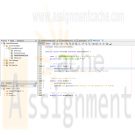
CMIS 141 Project 3 Stringed Musical Instrument Java Class and UML class diagram
$25.00CMIS 141 Project 3 Stringed Musical Instrument Java Class and UML class diagram
This project focuses on demonstrating your understanding of classes and objects. Before attempting this project, be sure you have completed all of the reading assignments listed in the syllabus to date, participated in the weekly conferences, and thoroughly understand the examples throughout the chapters. The project requirements include:
1. Design and implement a stringed musical instrument class using the following guidelines:
a. Data fields for your instrument should include number of strings, an array of string names representing string names (e.g. E,A,D,G), and boolean fields to determine if the instrument is tuned, and if the instrument is currently playing. You are welcome to add additional data fields if you like.
b. A constructor method that set the tuned and currently playing fields to false.
c. Other methods 1) to tune the instrument, 2) to start the instrument playing, and 3) to stop the instrument from playing.
d. Other methods as you see fit (Add at least one unique method).2. Create a UML class diagram using a diagram tool (e.g. PPT, Visio) of your choice. Prepare the diagrams and place them in a word document along with a brief description of each of your classes.
3. Create Java classes for your instruments. Be sure that your code matches your design specifications and some minimal functionality is included. For example, if you called the violin.play() method, you should at least print that the violin is playing. Similar functionality should be supplied when you stop playing, tune or call any of your methods. For example:
public void playviolin() {
System.out.println("The violin is now playing.");
}4. Write the output from your Instrument class methods to a text file that a user entered from the command line arguments (e.g. java Mynamep3tst myfilename.txt). This allows your program to accept filenames from the user via a command line argument.
5. Finally, create a Java test class that simulates using your instrument class. In your test class be you should at a minimum: a) Construct 10 instances of your instrument, b) tune your instruments, c) Start playing your instrument, d) Call your unique method, and e) Stop playing your instruments. (Hint: Arrays and Loops will make your job easier and result in more efficient code!)
6. Your programs should compile and run without errors.
7. Be sure to test your program carefully. Provide a list of comprehensive test cases used to validate your application and include these test cases in your word document containing your UML diagrams and descriptions. Similar to Project 1, your test data can be shown in a table that includes input data, expected output, actual output and pass/fail results from the test.
Learn More -

CMIS 141 Project 1 Java Program
$20.00CMIS 141 Project 1 Java Program
This project demonstrates your understanding of datatypes, input/output, sequential and selection programming statements, and mathematical operations.
Before attempting this project, be sure you have completed all of the reading assignments listed in the syllabus to date, participated in the weekly conferences, and thoroughly understand the examples throughout the chapters. The project requirements include:
1. Design and implement a Java program that will gather a user’s first name, middle initial, lastname, age in years, and 3 lucky numbers. The program should output the following based on the user’s input:
a. A welcome message repeating their full name (e.g. Welcome John Q Smith)
b. A message based on their age with these types of messages.
Display “You are just a kid!”, if the user is less than or equal to 12 years old
Display “Welcome teenager!”, if the user is greater than 12 and less than 20 years old
Display “Welcome almost adult!”, if the user is 20 years old.
Display “Welcome adult!” , if the user is 21 years old or greater.
c. A message displaying the average of their 3 lucky numbers. For example “The average of your 3 lucky numbers is : 20”2. Additional requirements include:
1. Use JOptionPane.showInputDialog() methods for your user to input their data
2. Use JOptionPane.showMessageDialog() methods to display your messages.3. Include a comprehensive set of application test data that you used to test your program. Your test data can be shown in a table that includes input data, expected output, actual output and pass/fail results from the test. Your test data can be presented in the form of a table as follows:
Submission requirements:
Learn More
Your deliverables include a Java file and a Word document. The Java file should be named Yournamep1.java. Your word document should include your test table and be named Yournamep1.doc. Your completed assignment should be submitted to your Project 1 assignment area no later than the due date listed in the calendar. -

Big Java Chapter 8 Programming Exercise P8.3
$5.00Big Java Chapter 8 Programming Exercise P8.3
Real cash registers can handle both bills and coins. Design a single class that expresses the commonality of these concepts. Redesign the CashRegister class and provide a method for entering payments that are described by your class. Your primary challenge is to come up with a good name for the class.
Learn More -
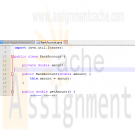
Big Java Chapter 8 Programming Exercise P8.4 BankAccount Solution
$5.00Big Java Chapter 8 Programming Exercise P8.4 BankAccount
Enhance the BankAccount class by adding preconditions for the constructor and the deposit method that require the amount parameter to be at least zero, and a precondition for the withdraw method that requires amount to be a value between 0 and the current balance. Use assertions to test the preconditions.
Learn More -
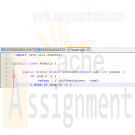
Big Java Chapter 8 Programming Exercise P8.13 Numeric Solution
$5.00Big Java Chapter 8 Programming Exercise P8.13 Numeric Solution
Consider the following algorithm for computing xn for an integer n. If n < 0, xn is 1/x–n. If n is positive and even, then xn = (xn/2)2. If n is positive and odd, then xn = xn–1 ⋅ x. Implement a static method double intPower(double x, int n) that uses this algorithm. Add it to a class called Numeric.
Learn More -
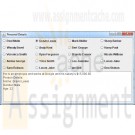
CMIS 242 Final Project Person Details
$15.00CMIS 242 Final Project Person Details
Learn More
This project focuses on demonstrating your understanding of Java Collections. Before attempting this project, be sure you have completed all of the reading assignments listed in the syllabus to date, participated in the weekly conferences, and thoroughly understand the examples throughout the chapters. The project requirements include:
1. Write a Java application that effectively uses Java collections to store up to 20 instances of the Person class and its subclasses. Then write a GUI that displays the Person names using radio buttons to select a name. When selected a TextArea of the GUI should display the information about the selected Person.
2. Your program should compile and run without errors. -
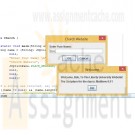
BMIS 212 Week 1 Programming Assignment
Regular Price: $15.00
Special Price $12.00
BMIS 212 Week 1 Programming Assignment
In this new age of Technology (Website, social media, etc., we have been given the opportunity to minister and serve others in many ways. Using the techniques you have learned in this chapter, write a program which displays at least 5 different sentences that explain how technology has been used to win souls to Christ.
Instructions: Write a portion of a program for a church's website. The program will be used for a chatting feature, which should include an Input Box that requests the user's name. The message box should include the user's name and the Scripture of the Day (chapter and verse only).
The program should be similar to the text below:
Welcome, Bob, To The Liberty University Website!
The Scripture for the day is: Matthew 6:11The assignment must have the following statements and components as demonstrated in the text:
1 Java file and 1 Class file
Variable
Input StatementProgram should follow Java Programming Conventions as shown in the Grading Rubric.
Exercise 2.14 Write an application that displays the numbers 1 to 4 on the same line, with each pair of adjacent numbers separated by 1 space. Use the following techniques:
Use 1 System.out.println statement
Use 4 System.out.print statements
Use 1 System.out.printf statementExercise 2.15 (Arithmetic) Write an application that ask the user to enter 2 integers, obtains them from the user and prints their sum, product, difference and quotient (division). Use the techniques shown in Figure 2.7
Exercise 2.26 (Comparing Integers) Write an application that reads 2 integers, determines whether the first is a multiple of the second and prints the result. [Hint: Use the remainder operator.]
Learn More -
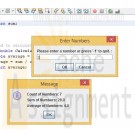
CMIS 141 Project 2
Regular Price: $15.00
Special Price $12.00
CMIS 141 Project 2
This project focuses on the use of of sequential, selective and repetitive programming statements, methods, and modular programming. Before attempting this project, be sure you have completed all of the reading assignments listed in the syllabus to date, participated in the weekly conferences, and thoroughly understand the examples throughout the chapters.
The project requirements include:
1. Design and implement a Java program that will gather a group of floating point numbers and determine the sum and average of the data entered. The program should use separate methods for inputting the data, calculating the sum, calculating the average, and displaying the results. A sentinel value should be used to indicate the user has completed entering their numbers. The output should display a message that includes the count of the numbers entered, the sum of the numbers and the average of the numbers. If the sum of the numbers is greater than 100, a warning message should be displayed indicating "values have exceeded a sum 100".2. Additional requirements include:
1. Use JOptionPane.showInputDialog() methods for your user to input their data
2. Use JOptionPane.showMessageDialog() methods to display your messages.
3. Include a comprehensive set of application test data that you used to test your program. Similar to Project 1, your test data can be shown in a table that includes input data, expected output, actual output and pass/fail results from the test.Submission requirements:
Learn More
Your deliverables include a Java file and a Word document. The Java file should be named Yournamep2.java. Your word document should include your test table and be named Yournamep2.doc. Your completed assignment should be submitted to your Project 2 assignment area no later than the due date listed in the syllabus. -
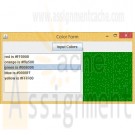
CMIS 242 Project 4 Color Menu
Regular Price: $25.00
Special Price $20.00
CMIS 242 Project 4 Color Menu
This project focuses on demonstrating your understanding of Java Collections. Before attempting this project, be sure you have completed all of the reading assignments listed in the syllabus to date, participated in the weekly conferences, and thoroughly understand the examples throughout the chapters.
Learn More
Write a Java application that effectively uses Collections to store custom color definitions (between 5 and 20, inclusive).
The user should assign a unique name to each color, and a unique hexadecimal value (e.g., red is #FF0000).
User input can be done in a GUI or on the command-line.
Your program should enforce uniqueness. In other words, if the user enters a name for a color that already has that name, then the user should be reprompted. (Same behavior for the hexadecimal value.)
Additionally, a GUI should be included that displays the color names and hexadecimal values.
Each name/value pair should be selectable via a radio button or other mechanism.
When a color is selected, an area of the GUI should change to that color (the area is up to you, as long as it's visible). -
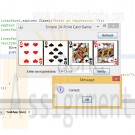
Introduction To Java 9th Edition Chapter 22 Exercise 13 The 24-point game
Regular Price: $25.00
Special Price $20.00
Introduction To Java 9th Edition Chapter 22 Exercise 13 The 24-point game
(Game: the 24-point card game) The 24-point game is to pick any 4 cards from 52 cards, as shown in Figure 22.19. Note that the Jokers are excluded. Each card represents a number. An Ace, King, Queen, and Jack represent 1, 13, 12, and 11, respectively. You can click the Refresh button to get four cards. Enter an expression that uses the four numbers from the four selected cards. Each number must be used once and only once. You can use the operators (addition, subtraction, multiplication, and division) and parentheses in the expression. The expression must evaluate to 24. After entering the expression, click the Verify button to check whether the numbers in the expression are currently selected and whether the result of the expression is correct. Display the verification in a dialog box. Assume that images are stored in files named 1.png, 2.png, . . . , 52.png, in the order of spades, hearts, diamonds, and clubs. So, the first 13 images are for spades 1, 2, 3, . . . , and 13.
Learn More




